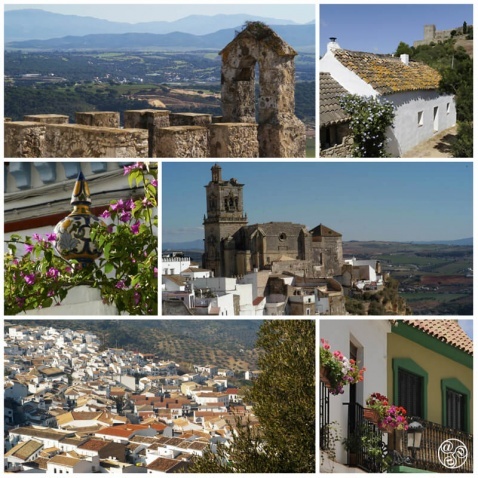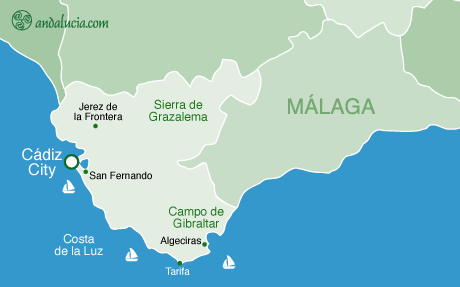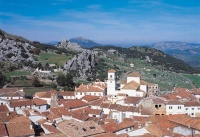
Cadiz villages clockwise: Vejer, Castellar, Arcos, Los Barrios, El Gastor, Ubrique © Michelle Chaplow |
|
Highlights of Villages & Small Towns of Cadiz province
Rugged mountains of Cadiz
The rugged hills known as the Sierra de Cádiz are densely wooded with pine trees and cork oaks. Here, clinging precariously to the edges of deep river gorges or perched on rocky cliffs, are a series of fascinating fortified towns, with whitewashed houses lining narrow, winding streets. These "pueblos blancos" (white towns) still bear the imprint of their defensive function in the 13th to 15th centuries, with ruined fortifications and walls, demarcating the former frontier (frontera) of the Christian and Muslim kingdoms.
A selection of quality, reliable villas and cottages in the Ronda mountains and Grazalema Natural Park from Andalucia specialists Rustical Travel.
Arcos de la Frontera is one of the most spectacularly placed white towns, dotted with fine churches and mansions and enjoying magnificent views over the Serranía de Ronda.
East of Arcos is Grazalema, in a similarly impressive location; approach the village on the A372 from Ronda for the best views of it looming ahead. Dwarfing the village are the barren, rugged peaks of the Sierra de Grazalema Natural Park, which hide the small but stunningly situated Zahara de la Sierra. A good base for exploring the park is El Bosque, which is close to a beautiful wooded river valley. Try the village's fresh trout, caught locally in the Majaceite river. North of the Sierra de Grazalema is Setenil de las Bodegas, which unlike most pueblos blancos was not constructed on a hill or rocky cliff, but nestles in a network of caves in a gorge. Also north of Grazalema is Olvera, worth a visit for its Moorish castle with magnificent views of surrounding hilltop villages and its nearby vía verde, a former railway line that is now a cycleway and footpath.
South of the Sierra de Grazalema is another protected area, the Alcornocales Natural Park, which as its name suggests, is heavily wooded with groves of cork oaks (alcornocales). The park office is in Alcalá de los Gazules, a good vantage point from which to view the park. South of Alcalá de los Gazules and just outside the park is Benalup, which is famous for its caves, the Cuevas del Tajo de las Figueras, with their Neolithic rock paintings and tombs. On the eastern fringes of the Alcornocales Natural Park is Jimena de la Frontera, dominated by a large ruined Moorish castle, and Castellar de la Frontera, a fortified hilltop village overlooking the Guadarranque reservoir. With its two disparate centres, the village has a curious history of resettlement. South of Castellar de la Frontera and just outside the park is the village of Los Barrios, with a pretty, flower-filled main street and the starting point of the Ruta de los Toros (Route of the Bulls).
Further south is one of the most attractive pueblos blancos, Vejer de la Frontera. The town sits on a rocky peak and is imbued with a strong Moorish feel about its winding streets radiating from a beautifully tiled main square at its centre. North of Vejer is the hilltop town of Medina Sidonia. Although not as popular as Arcos and Vejer, it has managed to retain its unspoilt character.
Fishing ports & coastal resorts
The ancient sea ports of the Cadiz coast were first developed by the Phoenicians, Greeks and the Romans. Many of these fishing towns and villages still have fleets in operation today, which supply some of the region's best seafood. Between Cadiz and Tarifa is one of Andalucia's most unspoilt coastlines, much of it protected, punctuated by small resorts that sit alongside pristine sandy beaches.
Northwest of Cadiz is the seaside town of El Puerto de Santa María, with a charming historic quarter and a well-earned reputation for producing fine sherry and brandy that you can experience for yourself; take your pick from any of the town's fine bars and restaurants to sample these drinks and some of Cadiz's best seafood tapas. Further along the coast are the fishing ports of Rota and Chipiona, the latter with a beautiful 12-km stretch of sandy beach that few foreign tourists visit, although it can be busy in summer with holidaymakers from Seville and Cadiz. The historic sea port of Seville, Sanlúcar de Barrameda, is famous for its manzanilla sherry that tastes of salty sea air.
Southeast of Cadiz and set back from the shore is the town of Chiclana, on the edges of a protected saltmarsh called the Marismas de Sancti Petri Natural Area. Chiclana's beach resort is Sancti Petri, which is worth a visit in summer for its boat trips to the Sancti Petri island with its lighthouse and ruined castle.
Further south are a series of small coastal towns and villages set in wild landscapes fringed by virgin beaches. Conil de la Frontera is the first of these, with a pretty, historic centre and main square, surrounded by a maze of streets, and a long, sandy beach. Further east along the coast is El Palmar, a beachside hamlet with a great campsite and a good choice of places to stay, well known for its superb dune-backed sandy beach. From here you can see the lighthouse on the Cabo de Trafalgar headland that marks the beginning of the small resort of Caños de Meca, a hippy hangout with a laid-back atmosphere and a nudist beach at its eastern end.
Although blighted somewhat by some ugly development and largely shunned by foreign visitors, the next resort of Barbate has an impressive 2km-promenade lined with bars and restaurants right by its extensive sandy beach. Between Barbate and Caños de Meca is a protected stretch of magnificent cliffs and pine forest, the Breña y Marismas de Barbate Natural Park, with a coastal walk that is well worth the effort for its wonderful views.
Zahara de los Atunes and Bolonia are two low-key resorts between Barbate and Tarifa, Bolonia being best known for its nearby Roman ruins, the settlement of Baelo Claudio.
Tarifa is synonymous with windsurfing as one of the world's prime locations for this sport. It is a lively, buzzing resort with loads to do; apart from the ubiquitous windsurfing, you can choose from kite surfing, scuba diving and whale- and dolphin-watching trips.
East along the coast from Tarifa is the industrial sprawl of Algeciras, Gibraltar and then, just off the coastal road, the small town of San Roque. It enjoys superb views of the Bay of Algeciras (if you turn a blind eye to the oil refinery), Gibraltar and the mountains of Africa on clear days, as well as having a beautiful pine forest, the Pinar del Rey, just to its north. San Roque is a great place for golfers, with no less than six golf courses in its municipality. Closer to the shore is Sotogrande, an upmarket residential development and marina near the river estuary nature reserve of the Estuario del Río Guadiaro Natural Area.

